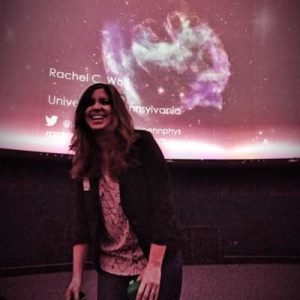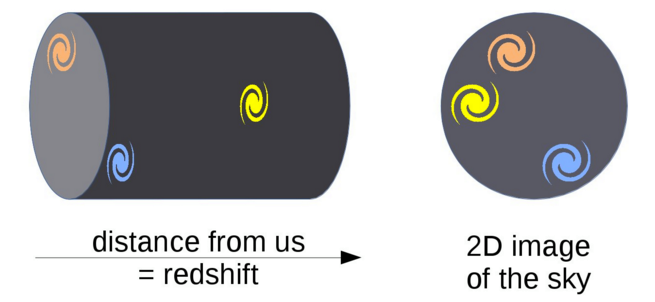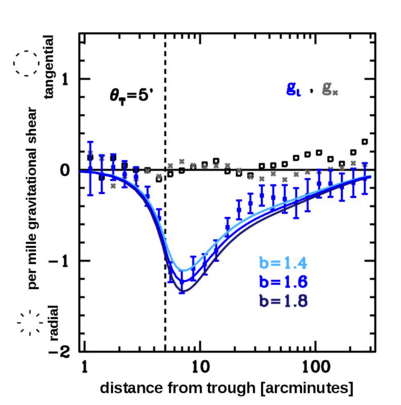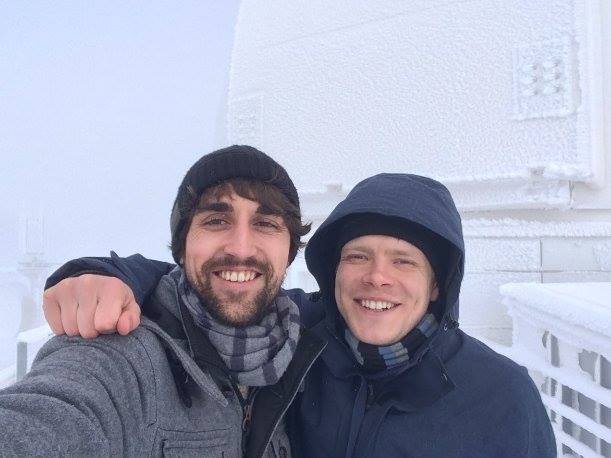Structures in the Universe exist in the form of both overdense regions, like galaxies or clusters of galaxies, and underdense regions, like cosmic voids. Underdense regions are, however, notoriously difficult to measure. In our paper, we have developed a new way of identifying and weighing cylindrical volumes with low matter density (which we call troughs) with weak gravitational lensing. Using early DES data, we make a measurement of lensing by troughs that is more precise than any measurement of lensing by underdense regions reported in previous studies. This is particularly interesting because empty regions are strongly influenced by Dark Energy, the elusive cause of the accelerated expansion of our Universe.
We find these troughs by searching for regions of the sky with the smallest numbers of galaxies. First, we take a two-dimensional DES image, draw a circle, and count the number of galaxies in the circle. Then we select the 20% of circles that have the fewest galaxies in them. These circles correspond to underdense cylinders in 3D space, which we call troughs.
Here is a basic example of how a 3D cylindrical volume translates into a 2D image on the sky.
Due to gravitational lensing, images of distant background galaxies surrounding the trough will appear very slightly radially aligned, i.e. look like they are pointing out from the trough. This is the opposite effect of what happens around massive structures like clusters of galaxies, which align background galaxy images tangentially, i.e. along a circle.
This figure below shows our measurements of how galaxies in the background of troughs are aligned due to gravitational lensing. The strength of this alignment measures how empty the troughs are. The alignment g (vertical axis) is plotted as a function of the distance (horizontal) from the trough center. A negative g of one per-mille, as we find it near the radius of the trough that is indicated by the vertical dashed line, means that background galaxies appear to be very slightly elliptical: on average, their long axis is aligned toward the trough center and one part in a thousand longer than their short axis.
Gravitational lensing causes such a radial alignment when a region in space contains less matter than its surroundings. We find that the measurement of this “missing mass” in troughs is consistent with a very simple model, based on basic statistics and our current understanding of General Relativity, Dark Energy, and Dark Matter. The prediction for the lensing signal of troughs based on this model is plotted in the above figure as the blue lines, for three different assumptions about the mass of the galaxies we are counting in different shades of blue, and is a good fit to our measurement.
The method we have developed is not only a general check of the basic concepts of cosmology, it is also a new way of finding out about some basic properties of the Universe quantitatively, such as how much matter it contains and how clumpy the distribution of that matter is. What we measure so far is consistent with what other experiments have found before by other means — but with the full DES dataset, we should be able to make these measurements with higher precision than any previous experiment. Also, many alternative theories of gravity and cosmology either predict that underdensities would grow at a different rate or gravitational lensing by underdensities would be stronger than in General Relativity. With future data, we hope to be able to distinguish between these models.
About the Paper Author
Daniel Gruen is a post-doctoral researcher at LMU Munich and started working on DES as a Master’s student in 2010. He is currently on the move to California to start his new job as an Einstein Fellow at SLAC National Accelerator Laboratory (Stanford). Daniel studied troughs together with Oliver Friedrich, who is working on DES during his PhD at LMU. The picture shows the two (left: Daniel, right: Oliver) on an observing shift at the telescope on Mount Wendelstein in the Bavarian alps, which, due to heaps of snow, turned into a workshop on troughs at the peak.
About The DArchive Authors & Editors

Rachel C. Wolf is an astrophysics PhD candidate at the University of Pennsylvania. She is primarily interested in how to best use Type Ia supernovae to understand more about the evolution of our universe. Most of her work has focused on studying correlations between supernova brightness and host-galaxy properties and on creating new statistical techniques to compare observational data to cosmology theory. Rachel is also very passionate about science education and public outreach. She is involved in many projects in the Philadelphia community and serves as one of the co-coordinators of Education & Public Outreach for DES.
Anthony Kremin is a PhD student at the University of Michigan.


